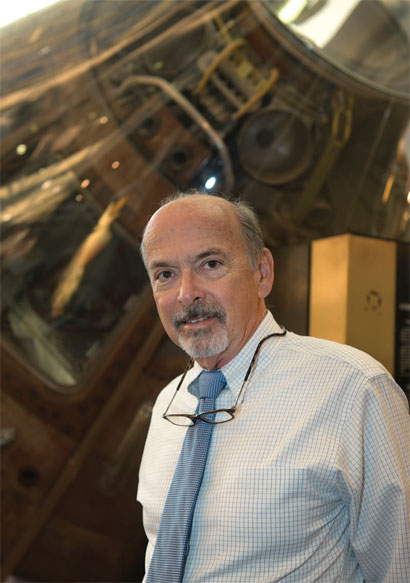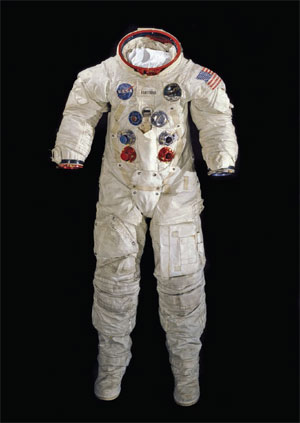
Space man: Allan Needell ’72.
On the second floor of the National Air and Space Museum is one of its most venerable exhibits: “Apollo to the Moon,” which showcases artifacts from the space race that culminated in the 1969 lunar landing. Watching visitors mill around its galleries—viewing objects from the mundane (a spoon used on Apollo 11) to the massive (a repurposed Apollo command module that ferried astronauts to Skylab)—it’s easy to forget that when the museum opened during the U.S. Bicentennial in 1976, the gallery told a tale that many had watched unfold in their own living rooms. “It was current events,” says Allan Needell ’72, curator of the museum’s Apollo collection. “The last astronaut to walk on the moon was in 1972.”.
Decades later, the moon landing is approaching its fiftieth anniversary. And the exhibit—with its dim lighting, oddly angled walls, and static presentations—is looking a bit careworn. “It has been altered several times, and it no longer makes any sense,” Needell says, pausing at the entryway where a TV monitor has JFK urging Congress toward the moon on an endless loop. “This is the only attempt at a historical context; the rest is just stuff.” Much of that stuff—astronaut booties, rock-gathering gizmos, zerogravity pens—is on display along one wall, inside a jam-packed vitrine labeled ASTRONAUT TOOLS AND EQUIPMENT. When you consider it critically, it’s hard to imagine how so many cool things could seem so dull. “This is awful exhibitry— but it’s great stuff,” Needell says. “In 1976, this was the technique for hanging things; there’s nothing interactive. We don’t do things like that anymore. All of this will be upgraded.”
The upgrade in question is a strippedto- the-walls overhaul of the Apollo galleries, a project that Needell is helping to oversee. Sometime around the turn of the decade—though, he admits, likely not in time for the Apollo 11 anniversary in 2019, due to an upcoming upgrade of the building’s infrastructure—the museum will unveil newly imagined galleries tracing the social, scientific, and political history of the lunar missions. It will have, as its centerpiece, the Columbia command module from Apollo 11—currently located in the vast Milestones of Flight gallery, itself set for a major renovation—and include a forum for visitors to contemplate the moon’s future. (A mine for precious metals? A launch base for a Mars voyage? The object of a next-generation space race?) “People have always been fascinated with the moon,” Needell observes. “In the Sixties, a special geopolitical situation wound up with twelve people actually walking around up there. Since then, there have been other priorities for our space activity—but the moon has continued to have interest.”

Astronaut Neil Armstrong’s space suit.
A physics major on the Hill, Needell holds a PhD from Yale in the history of science. He’s been at Air and Space since 1981—and though his job would be the envy of many a space junkie, he says he was never the sort of kid who dreamed of donning an astronaut’s helmet. “We have these space simulator rides here, and I don’t go on them,” Needell says with a laugh, as the kid-heavy summertime crowd roars around him on a Friday in July. “I don’t even like roller coasters.” Among his proudest achievements is overseeing the restoration of one of the few surviving Saturn V rockets, which were created to launch Americans into space; the massive artifact, housed at NASA’s Johnson Space Center in Houston, was unveiled in 2007. “Kennedy said, ‘Let’s go to the moon’; how were we going to do that?” Needell muses. “We had been losing the space race. The Soviets had Sputnik; they put the first man in space, then the first woman.” Why? “They had bigger rockets. Both theirs and ours were adapted versions of military missiles—but because our bombs were more sophisticated and smaller, our rockets didn’t have to be as big. So we needed a whole new generation of rockets.” The current Apollo galleries include the aft end of a Saturn V, prominently featuring its F-1 engines. Needell would love to see it mounted from the ceiling in the new exhibit, so visitors can stand under it and appreciate its massive scope. Plus, he says: “It would be a wonderful place to propose to your girlfriend.”

The Columbia command module.
Along with the glamorous parts of the job—like meeting people who’ve walked on the moon—come more earthly curatorial tasks, like figuring out the logistics of dangling thousands of pounds of rocket engine. Needell and his colleagues wrestle with such challenges as how to conserve— but also display—the original Apollo spacesuits, endangered by astronaut sweat and degrading plastic tubing. Needell is also contributing to the Milestones of Flight renovation, which will include the relocation of an Apollo landing module that’s currently at the museum’s far end, adjacent to the cafeteria. It was used only for testing, but it’s been meticulously mocked up to look like the Eagle from Apollo 11. (As in: “The Eagle has landed.”) In the renovated gallery, it will dwell beneath Charles Lindbergh’s Spirit of St. Louis. “We’re seeing the transformation from current events to recent history to ancient history,” Needell says above the din. “A lot of these kids don’t distinguish in a qualitative way between Lindbergh flying over the Atlantic, World War II, the Vietnam war, the space race, World War I, Montgolfier going up in a balloon. To them, it’s all ancient history.”


